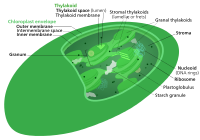Calvin cycle

Okay, kiddo, so imagine you have a garden, and you want to grow some yummy plants like tomatoes, cucumber, or lettuce. But, for that, you need two things - sunlight and food. Right?
Now, let's talk about how plants make their food. There's a process called photosynthesis that helps plants make their own food like glucose, using sunlight, water, and carbon dioxide (CO2).
But, photosynthesis is not one simple thing; it has two sets of steps - the light reaction and the dark reaction (also called the Calvin Cycle).
Now, we will focus on the second set of steps called the Calvin Cycle. It's like a factory inside the plant cell that makes food using the energy from the sun.
The Calvin Cycle takes place inside the chloroplasts, the green-organs of the plant cell. It uses energy stored from the light reaction (the first set of steps) to convert CO2 into sugar (glucose) - the food for the plant.
It's just like baking a cake where you mix flour, sugar, and butter to bake a cake. In the Calvin cycle, plants combine CO2 with other molecules to make glucose using the energy from the sun.
The Calvin Cycle includes three main steps - Fixation, Reduction, and Regeneration. Each step uses different enzymes and other molecules to make sure that the right reactions happen at the right time.
In the Fixation step, the plant takes CO2 from the air and turns it into organic molecules. These molecules are then broken down into smaller units in the Reduction step, and they are combined to make glucose in the Regeneration step.
So, the Calvin Cycle is like a complicated assembly line in a factory, where different things happen in different steps to make a product. And, the product here is the sugar (glucose) that plants use as their food.
Now, let's talk about how plants make their food. There's a process called photosynthesis that helps plants make their own food like glucose, using sunlight, water, and carbon dioxide (CO2).
But, photosynthesis is not one simple thing; it has two sets of steps - the light reaction and the dark reaction (also called the Calvin Cycle).
Now, we will focus on the second set of steps called the Calvin Cycle. It's like a factory inside the plant cell that makes food using the energy from the sun.
The Calvin Cycle takes place inside the chloroplasts, the green-organs of the plant cell. It uses energy stored from the light reaction (the first set of steps) to convert CO2 into sugar (glucose) - the food for the plant.
It's just like baking a cake where you mix flour, sugar, and butter to bake a cake. In the Calvin cycle, plants combine CO2 with other molecules to make glucose using the energy from the sun.
The Calvin Cycle includes three main steps - Fixation, Reduction, and Regeneration. Each step uses different enzymes and other molecules to make sure that the right reactions happen at the right time.
In the Fixation step, the plant takes CO2 from the air and turns it into organic molecules. These molecules are then broken down into smaller units in the Reduction step, and they are combined to make glucose in the Regeneration step.
So, the Calvin Cycle is like a complicated assembly line in a factory, where different things happen in different steps to make a product. And, the product here is the sugar (glucose) that plants use as their food.
